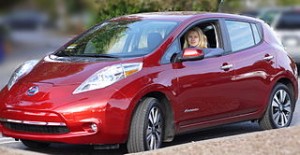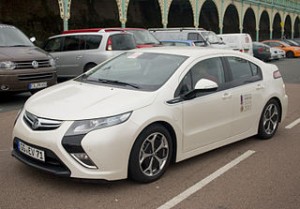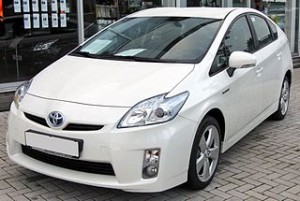Different Types of EV
Battery Electric Vehicle (BEV)
A battery electric vehicle (or BEV) is any form of transport which uses only electric power to drive the vehicle under all circumstances. There are no back-up internal combustion engines in the vehicle which allow it to continue in the event of the battery being drained. This is alternatively referred to as a “full EV” or “pure EV”.
Examples:

© Daniel Cardenas / CC BY-SA 3.0
- Nissan Leaf
- Renault Zoe, Fluence
- BMW i3 (without Range Extender)
- Tesla Roadster, Model S
Extended Range Electric Vehicle
An extended range electric vehicle (or EREV) is one which uses electric power to drive the vehicle but that has an internal combustion engine that can run to provide the electric power. Sometimes called a Series Hybrid Electric Vehicle, it differs from a conventional hybrid in that the motive power is always electric in an EREV whereas in other hybrids the motive power switches between electric and internal combustion engine.
Examples:

© M 93 / CC-BY-SA-3.0 (DE)
- Vauxhall Ampera
- BMW i3 (with Range Extender)
Plug-in Hybrid
A Plug-in Hybrid Electric Vehicle (PHEV or PH-EV) is well described in Wikipedia). PHEV can be seen as transition technology allowing drivers to move from diesel or petrol cars to electric driving, but with the backup of another power source should they run out of battery charge.
However the capabilities of PHEVs available vary widely in terms of how they can be used. Some can be used for many miles entirely on electricity, with an internal combustion engine (ICE) that takes over once the battery is drained. Others use battery power at low speeds and low power requirements but use the ICE once power requirements increase. Yet others use electricity for all driving but have an ICE as a generator purely as a fall-back in the case of getting low on charge but not intended for extended use. All of these variants are called PHEVs but suit different needs and so each make and model needs to be understood before purchase to make sure it operates in the way that the driver requires.
A PHEV differs from other Hybrid vehicles in that it can be plugged in to charge up the battery. This is a very important difference because it allows the car to be driven on cheap and clean grid electricity rather than having to use the petrol or diesel to charge the vehicle’s battery before the vehicle can use electric drive.
Some PHEVs are also EREV.
Examples:

© Dominic Alves CC BY 2.0
- Vauxhall Ampera
- BMW i3 (With Range Extender)
- Chevrolet Volt
- Toyota Plug-in Prius
- Volvo V60 Plug-in
Hybrid Electric Vehicle
A Hybrid electric vehicle is a vehicle that can generate its motive power from a petrol or diesel engine and from an electric motor.
Hybrid electric vehicles were first made popular with the Toyota Prius. The non plug-in Toyota Prius got all of its energy from petrol but it can store charge into a battery while the engine is running or while regenerative braking is taking place. This stored electric power can then be used to supplement the engine to improve economy and/or performance.
Since the Prius there have been many more Hybrid electric cars launched from manufacturers such as Toyota (Auris, Yaris), Honda (Insight), Lexus (440h). While these cars might use very different systems they are do the same thing… the recover energy during braking, storing it in a battery and then using it for propulsion thereby ensuring it is not wasted as with more traditional cars.
Examples:

© S 400 HYBRID
- Toyota Prius (non-plug-in), Auris, Yaris
- Honda Insight
- Lexus hybrids
